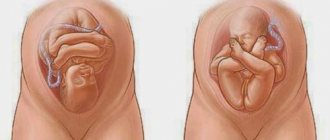Why does the fetus kick?
At what month of pregnancy does the baby begin to move? In the initial trimester, the fetus grows and develops week by week, and with it comes movement and the desire to “dance” in the womb. As the child's size increases, within certain time limits the baby's first movements and first movements are possible.
Factors that influence fetal movements are:
- The atmosphere, quiet or loud around, familiar or unfamiliar voices.
- Lifestyle. Is your accent active or passive? After all, the more active you are during the day, the more active your baby is at night.
- Psycho-emotional stress: stress, fatigue, overwork, drowsiness and anxiety - your baby will behave more active and painful sensations may appear during fetal movements.
- Diet - hunger or overeating affects the baby, causing him to be hyperactive or, conversely, hypoactive.
- Body position in space. When you take a body position that is uncomfortable for you, you can press down the vessels that saturate the fetus with oxygen. Due to possible hypoxia, the fetus begins to show excessive activity.
Normal fetal movements
Over the course of 9 months, the baby grows and develops, its body size increases, and by the end of pregnancy it is in cramped conditions. During pregnancy, the number of movements also changes. The child is in motion most of the time, the lull occurs during sleep.
By the 20th week of pregnancy, fetal movements reach 200 times per day. At 26–30 weeks – about 600 movements.
Subsequently, the number of active movements decreases, and before childbirth they become rare. It is worth noting that a pregnant woman does not feel more than half of the movements. On average, movements occur 10–15 times in one hour. During the period when the child is sleeping, they are normally absent for up to 3 hours. Fetal mobility depends on the following factors:
- Physical stress experienced by a pregnant woman. The calmer the woman behaves, the more actively the fetus performs movements.
- Nutritional pattern of a pregnant woman. If a woman is hungry, the baby moves more and the kicks are felt more strongly. When eating sweets, movements become more active.
- Times of Day. Maximum activity in the fetus appears in the evening and at night.
- Incorrect body position of a pregnant woman. At the same time, the fetus begins to move strongly and frequently, causing pain in the woman.
- Psycho-emotional state of a woman. Under severe tension (stress, fear), the fetus may be overly active or, conversely, subside.
- Ambient sounds and bright light cause an increase in motor activity or, conversely, its subsidence.
Sensation of baby moving
At what weeks does the baby begin to move? The fetus begins to make its first independent movements at the age of 7-8 weeks. However, at this time they are difficult to notice due to the extremely small size of the unborn child. By the age of 10 weeks, fetal movements begin to take on a conscious character, for example, when there is pressure on the uterus, the baby begins to turn towards the stimulus. But at this time, the expectant mother has a thought - I don’t feel the baby’s movements, because its size is too small.
During the first pregnancy, a woman can feel the first fetal movement between 18 and 22 weeks , but in most cases this occurs at 20 weeks. It has been noticed that thin expectant mothers begin to feel fetal movements earlier, usually at 19-20 weeks. On the contrary, at how many weeks does the baby move for women of larger build - they notice the first movement of the fetus at 21-22 weeks.
First trimester
The first movements of the fetus during the first pregnancy at what stage are usually very weak and difficult to notice. At this time, the baby makes about 200 movements per day, but not all of them remain noticed. The movements of the fetus at this time are varied, by this time the limbs are almost completely formed, the child begins to move them, pushing away from the walls of the uterus. The first signs of the baby moving are sensations similar to tickling or light stroking from the inside of the abdomen.
Second trimester
In the middle of the second trimester, the type of fetal movements changes - they take on the character of tremors, which people around can feel by placing their palm on the stomach. By this time, the nervous system is developing, so fetal movements become more varied. The baby swallows amniotic fluid, turns its head towards the stimulus, moves its limbs, sucks its finger, and touches the umbilical cord. The number of movements per day during this period reaches 600.
Third trimester
By the end of the second and beginning of the third trimester, fetal movements become more intense; expectant mothers describe them as “kicks.” At 30-32 weeks, the unborn baby occupies a certain position in the uterus, so the localization of its movements becomes constant. As birth approaches, the number of movements per day decreases due to the increase in the size of the baby, which becomes difficult to move.
Baby moves: count to 10
This is the simplest and most common test of baby D. Pearson's movements. It is recommended by the Ministry of Health of the Russian Federation and is indicated in official documents on the management of pregnancy in our country. It can be used by everyone from 28 weeks at home to independently monitor the baby’s condition. In a special table, every tenth movement is noted from 9:00 to 21:00. This is how the characteristics of his motor activity are determined. Under normal conditions, the tenth movement is noted before 17:00. If the number of movements within 12 hours is less than 10, it is advisable to inform your doctor. If the baby does not make itself known within 12 hours, it is an emergency, see a doctor immediately!
The second test recommended by our gynecologists is counting movements within an hour. There should be 10-15 of them. If it is more or less, you must definitely draw the attention of a doctor.
If the baby does not move for three hours, there is no reason to worry. He might just be sleeping.
Early fetal movements
Is it possible? Many first-time pregnant women expect the first signs of the baby's movement already at the twelfth week.
Did you feel any movement? Only this is not a child, these are accumulated gases and displacement of organs due to the increasing size of the uterus.
At what point does the baby begin to move - namely, from the eighteenth week to the twenty-second - fetal movements are more often noticed. You may be kicked with an elbow or knee.
Multiparous pregnant women may feel movements earlier - at the sixteenth week. Why? Because the mother’s body has experience and physical preparation for pregnancy and childbirth. The abdominal wall remembers how to stretch, the familiar sensations of fetal movement - the framework tightens for a week or more. Even in your third pregnancy, you can feel fetal movement at the fifteenth week.
What does the movement feel like? The expectant mother senses the motor activity of the fetus due to the influence of mechanoreceptors. Initially, symptoms may be subtle. Closer to the twentieth week you will feel everything more acutely.
- Butterflies fluttering in the stomach
- Tickling or stroking the inner wall
- Wave-like movements in the abdominal area
- Shocks from small range to large in strength
- Gurgling sensations in the stomach
How to understand movements?
Imagine the feeling of being pushed from within or some kind of vibration occurring (again, from within). Some people confuse the baby's movements with churning in the stomach. The longer the period, the more distinct the pushing becomes.
You can feel the first movements from 16-24 weeks of pregnancy. You must remember this moment (how can you not remember it) and tell your gynecologist about it. The doctor will record this information on your exchange card.
More experienced mothers can already determine by the kicks how the baby is positioned. If the tremors are felt in the lower abdomen, then the baby is head up, and if you feel movements in the diaphragm, then the baby is head down.
Process Features
In the womb, the child grows and develops. The baby makes movements invisible to the mother to ensure his personal comfort. Movement is felt in a pregnant woman at the very beginning of the first trimester; you can notice it as early as the twelfth week during an ultrasound of its “tumbling” in the womb. The first movements of an arm or leg occur in the eighth or ninth week of pregnancy, according to the obstetric period the eleventh week. The baby’s bones become overgrown with muscle fibers, forming the rudiments of muscles, and neurons. This makes the baby's movements more like convulsions or shudders. The fetus is in the amniotic fluid, and even at sixteen weeks the child’s physical activity may be imperceptible.
The expectant mother feels the first characteristic movements of the fetus between the eighteenth and twenty-second weeks, when the baby’s brain forms activity and performs acts of motor activity. Your obstetrician-gynecologist will date birth from the beginning of characteristic fetal movements.
Monitoring the child's activity
What matters is the change in the child’s physical activity over several days. Unusually strong, erratic, threshing movements will indicate a violation of his condition. A possible reason for this increase in reflex activity is an increase in carbon dioxide in your blood. The doctor will order additional laboratory tests and give recommendations.
A decrease or cessation of the baby’s movements after vigorous physical activity may be a sign of hypoxia, when the child lacks nutrients and oxygen. Placental insufficiency can be triggered by poor health of both you and the baby. We will have to establish the degree of development of hypoxia. In the acute form, emergency medical care is required; in the chronic form, constant monitoring and treatment is required.
Harbingers of tremors
To better understand the development of pregnancy and the movements of your baby, you should know the development of the embryo and subsequent fetus. At what month of pregnancy does the fetus begin to move?
Starting from the tenth week, neuromuscular bundles are formed from fibers of muscle and nervous tissue - providing movement for the child.
The child's skeletal and smooth muscles develop from neuromuscular bundles. Somewhere from the sixteenth week, you can calmly feel the first movements of your baby, which are often similar to convulsions, as well as possible gurgling - “bathing” the baby in the womb. How to move a baby in your stomach?
What are the harbingers?
- The belly increases in size and volume, the baby grows and takes a certain position, which changes throughout pregnancy.
- Belly movement or “walking” – your baby begins to roll over.
- Constipation, with compression of the rectum, is also one of the factors in your child’s motor activity.
- “Float in your stomach like a butterfly”
One thing is for sure, you will remember your baby’s first push for the rest of your life, it could be a kick from the child’s hand or foot. Remember at what stage your baby is moving.
Changing the intensity of movements
If the baby is well and comfortable in the womb, and the mother does not experience any external or internal stimuli, then the movements are rhythmic and smooth. Otherwise, the nature of the movements changes sharply, which should alert the woman and requires consultation with an obstetrician.
As a rule, a woman is aware of the baby’s activity when she is calm and resting. Conversely, many mothers are afraid that during her vigorous activity the child does not move at all. This phenomenon is easily explained. When a woman is at rest, she listens more carefully to her feelings and carefully notes the baby’s movements. When she is busy, she does not have time to escape from her work and she simply does not notice that the baby is moving. In order to dispel her doubts (the child is not feeling well, he is dying), the pregnant woman should sit down and relax, watching how he moves.
Doctors very often advise pregnant women to take the bed rest position - on the left side. It is in this position that the blood supply to the uterus is enhanced, which is used in the treatment of chronic fetal hypoxia and for its prevention.
It is possible that the activity may change due to an uncomfortable or incorrect position of the woman’s body, for example, lying on her back or sitting with a straight back. When the expectant mother lies on her back, the pregnant uterus strongly compresses the inferior vena cava (one of the main blood vessels).
When this vessel is compressed, blood flow to the uterus is significantly reduced and the baby begins to experience oxygen deficiency.
So that mommy understands that he is not feeling well, he begins to have violent and frequent movements. It is quite simple to establish blood circulation and eliminate hypoxia - the mother should turn on her side.
What fetal movements should there be before birth?
Before birth, the baby may lie low - there may be no movements, and this is absolutely natural. It’s just that your baby is about to be born, he is accumulating strength for further work. Of course, there will not be a complete absence of movements, but barely noticeable movements are one hundred percent.
At what week of the first pregnancy does the fetus begin to move?
When does the baby start to move during the first pregnancy? According to statistics, the first movements begin around the twentieth week. The child makes about two hundred movements per day, and by the thirty-second week up to six hundred movements per day.
Painful sensations may appear with oligohydramnios, and with polyhydramnios, the expectant mother ceases to feel the movements of the fetus.
Movement language
Sometimes movements become especially intense in a short period of time. This baby is “protesting” because of your uncomfortable position. If you lie on your back for a long time, the large vessels of the uterus are compressed and blood flow to the fetus is reduced. By his actions he is trying to force you to change your position.
The baby calms down during the cold spell, when you are worried, worried, sitting in one position for hours. Try eating something sweet - he should respond to the treat. He benefits from walking in the fresh air for at least three hours a day, good nutrition, long sleep, and a reasonable alternation of work and rest.
The child also really wants you to communicate with him. In the last weeks of pregnancy, his movements can sometimes cause pain and discomfort. Change your body position, stroke your belly, say a few kind words to the mischievous person, and everything will return to normal.
How many weeks does the baby start to move during the second pregnancy?
When does the baby start to move during the 2nd pregnancy and during the 3rd pregnancy? As a rule, the first fetal movement in a second pregnancy occurs earlier than in a first-time mother, usually at 18 weeks of pregnancy. Some expectant mothers with experience - you begin to feel fetal movements at 17 and even 16 weeks of gestation.
An expectant mother awaiting the birth of her second child feels the first movements earlier for several reasons:
- A repeatedly pregnant woman is familiar with the feeling of the baby moving, so she does not confuse it with increased intestinal motility.
- Often, during a second pregnancy, the size of the fetus is larger than in first-time mothers, and the movements of a large baby are easier to notice.
- The abdominal muscles of a woman giving birth are more sensitive to fetal movements.
.At what stage is the baby’s movement felt? Not all re-pregnant women feel the baby’s first movements at 16-18 weeks. At what stage of pregnancy does the baby begin to move? It is considered normal if the fetus begins to kick before the 24th week of gestation.
What you need to know about fetal movements
- Fetal movements may be slightly painful
How does the baby move in the stomach? When you feel the baby’s movements and they are painful, especially during your first pregnancy. Soreness is possible in the late stages of pregnancy, when the baby feels discomfort due to its proportions in the body, there is not enough space for it and it begins to push the space around itself, causing you pain. Pain is also affected by the stuffiness and cleanliness of the air around you, as well as your diet; usually the child experiences discomfort when hungry and stuffy. However, movements may be painful due to possible complications of the fetus or the course of pregnancy. I advise you to contact your obstetrician-gynecologist and undergo laboratory tests to exclude possible complications or begin to treat them.
- Nimble baby: why are fetal movements too active?
When the baby begins to move in the stomach during the 1st or 2nd pregnancy, many factors influence it. The fetus begins to push in the womb more actively at later times of the day. If the expectant mother leads an active lifestyle at night, when the baby is resting and sleeping, then the baby will lead an active lifestyle at night, when you want to rest. The active lifestyle of the fetus is also affected by the timing of your diet, if you are hungry or have just eaten. Sharp sounds or voices unfamiliar to the child also affect the baby’s activity. Your stress, illness, fatigue or excitability affects the high or even low activity of the fetus. Try to take control of your activity, psycho-emotional state, your environment and diet. A comfortable environment will be created for your baby and excessively active fetal movements will come to normal - weekly table.
- How is oxygen starvation of the fetus formulated?
Fetal movements are not only a way for a child to communicate with his mother and the outside world, but also a method for assessing his condition. When the baby is healthy, his movements are moderately active, have a certain routine, and do not cause severe inconvenience to the woman. Based on changes in the nature of movements, one can suspect some pregnancy pathologies, in particular fetal hypoxia.
Fetal hypoxia is a state of oxygen starvation of the unborn child. If the baby develops hypoxia, the expectant mother may notice that the number of his movements has decreased. In order to verify this, there are various methods, the simplest is the Cardiff test, which has a second name - “count to 10”.
A decrease or increase in fetal movements may be a symptom of pregnancy complications, especially fetal hypoxia, therefore, if the nature and number of movements of the unborn child changes, the woman should undergo a thorough examination.
The Cardiff technique involves the expectant mother recording every fetal movement for 12 hours. If the number of movements reaches at least 10 in an hour, the child is healthy. You can start the test at any time. The number of movements per hour less than 10 is a reason to consult a doctor.
But excessive activity of the fetus is a cause for concern and can serve as a signal of hypoxia in the unborn child. If the baby is suspected of oxygen starvation, the doctor performs a CTG, which assesses his condition and makes a final diagnosis.
Even while in the womb, a child during the second pregnancy develops a certain character; therefore, some children move a lot during pregnancy, while others, on the contrary, calmly wait for birth. Therefore, it is more important for the expectant mother to observe the movements of the fetus in dynamics in order to notice a weakening or increase in activity. Changes in the number and nature of the baby's movements are a reason for a visit to the doctor, who, using special equipment, will confirm or refute the diagnosis and, if necessary, prescribe treatment.
- The little “astronaut” is always on the move
Obstetricians and gynecologists recommend keeping records of your baby's physical activity—the movements of your child. How to count correctly?
The table can exist in three (3) versions:
Pearson method
fetal movement test, based on measuring the tenth fetal movement. During the day, you should feel your child’s movements; in order to accurately determine the tenth, write down the time in a special table. Measurement time: from nine in the morning until nine in the evening, the first movements during the first pregnancy.
Cardiff method
involves observation for twelve hours, you can choose the time yourself. When the baby moves for the tenth time, write down the time on a special form.
Why count movements?
To determine the normal value of movements, a special test has been developed, during which the tremors are counted.
The technique is as follows:
- movement counting begins at 28 weeks of gestation;
- the expectant mother must refuse to do any business during this period;
- counting starts at 9 a.m. and ends at 9 p.m.;
- any movements are taken into account (small, light, heavy, etc.);
- the normal value is 10 or more movements;
- In order not to lose track of your calculations, you need to keep a map or regular records.
A test for the amount of movement is necessary to assess the condition of the fetus.
If the fetus moves less than 10 times, this is a serious reason to consult a doctor.
The absence of tremors for 12 hours carries an unfavorable prognosis.
Diagnosis of pathologies
An important analysis is screening. Blood tests for chromosomal abnormalities (Down syndrome) should be performed at 12, 20 and 30 weeks.
Pathology diagnostics include blood tests for AFP, PAPP-A and hCG. Performed in conjunction with ultrasound.
When diagnosing developmental disorders, some fetal diseases can be detected by ultrasound. The presence of abnormalities can be determined after undergoing an ultrasound or blood test.











